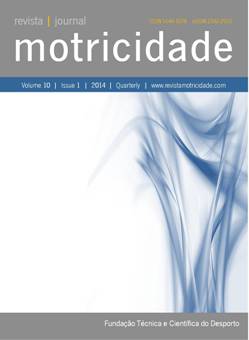Burnout em tenistas brasileiros infanto-juvenis
DOI:
https://doi.org/10.6063/motricidade.2713Resumo
O presente estudo teve como objetivo investigar a síndrome de burnout em tenistas infanto-juvenis brasileiros. A amostra foi composta por 88 tenistas sendo 69 meninos (M= 15.3 anos, DP= 1.2) e 19 meninas (M= 15.1 anos, DP= 1.3) que responderam ao Questionário de Burnout para Atletas e a um questionário de caracterização. Utilizou-se de estatística descritiva (frequências, percentuais, máximo e mínimo) e inferencial não-paramétrica (Kruskall-Wallis e Mann Whitney), estabelecendo-se significância de p< 0.05. Tenistas com menor tempo de prática (1 a 3 anos) apresentaram menores índices de exaustão física e emocional (p= 0.005, D= −0.57) quando comparados com os que treinavam há mais tempo (4 a 7 anos). Tenistas com menor volume de treino (até 10 horas por semana) apresentaram maiores índices de burnout (p= 0.009, D= 0.33), desvalorização desportiva (p= 0.011, D= 0.56) e baixo senso de realização desportiva (p= 0.002, D= 0.44) do que os com maior volume (11 a 20 horas por semana). As associações encontradas vão ao encontro de pressupostos teóricos da síndrome de burnout em atletas e pesquisas que investigaram essa população.
Downloads
Publicado
Edição
Secção
Licença
Os autores dos manuscritos submetidos para publicação deverão ceder, a título integral e permanente, os direitos de autor (copyright) à revista Motricidade e às Edições Sílabas Didáticas. A cedência de direitos de autor permite a publicação e divulgação do artigo em formato impresso ou eletrónico e entrará em vigor a partir da data de aceitação do manuscrito. Os autores concedem, ainda, os direitos para a revista Motricidade utilizar e explorar o respetivo artigo, nomeadamente para licenciar, ceder ou vender o seu conteúdo a bases de resumos/indexação ou outras entidades.
Nos termos da licença “Creative Commons”, os autores poderão reproduzir um número razoável de exemplares para uso pessoal ou profissional, mas sem fins comerciais. Nos termos da licença SHERPA/RoMEO, os autores poderão, ainda, disponibilizar/arquivar uma cópia digital final (versão postprint) do artigo no seu website ou no repositório científico da sua instituição.


